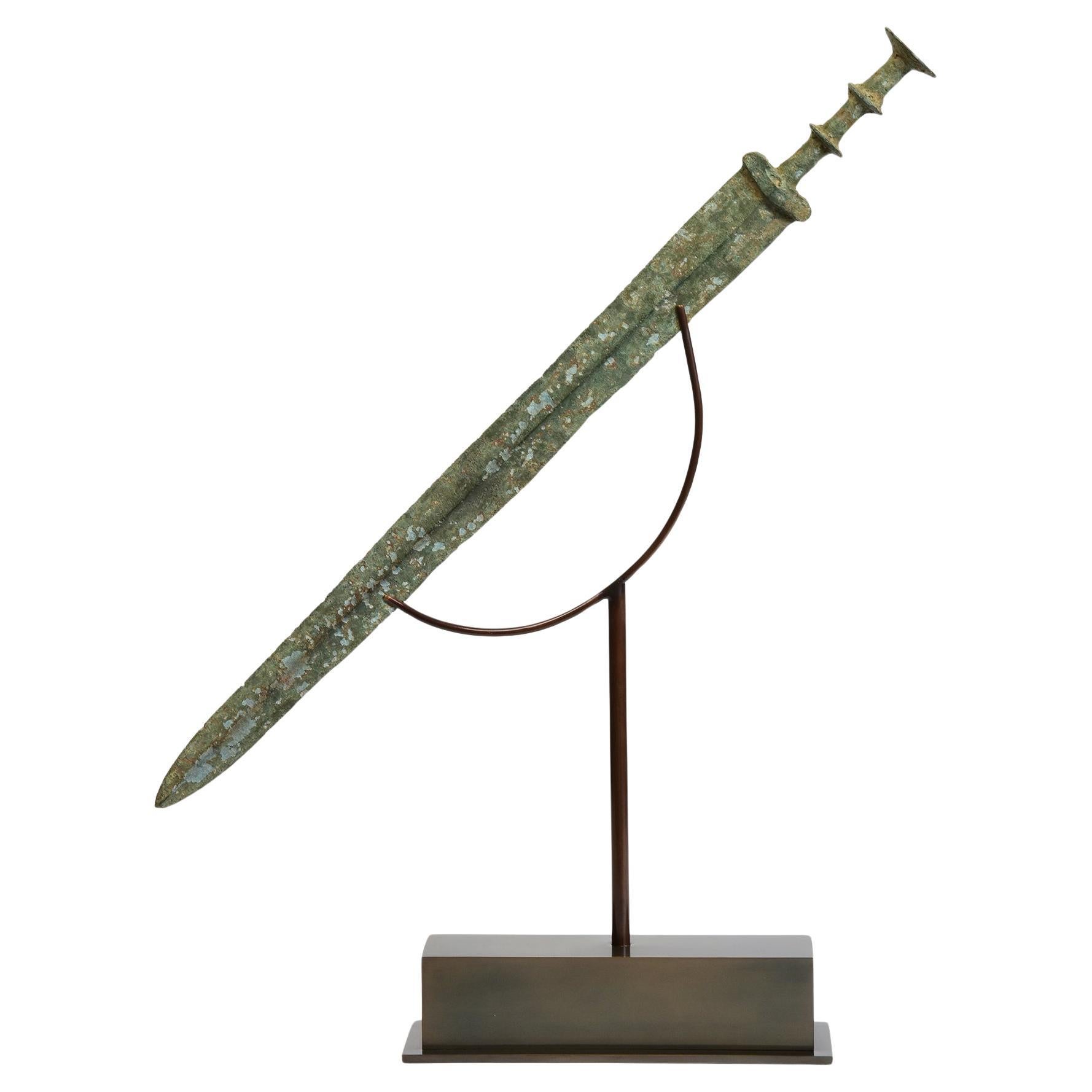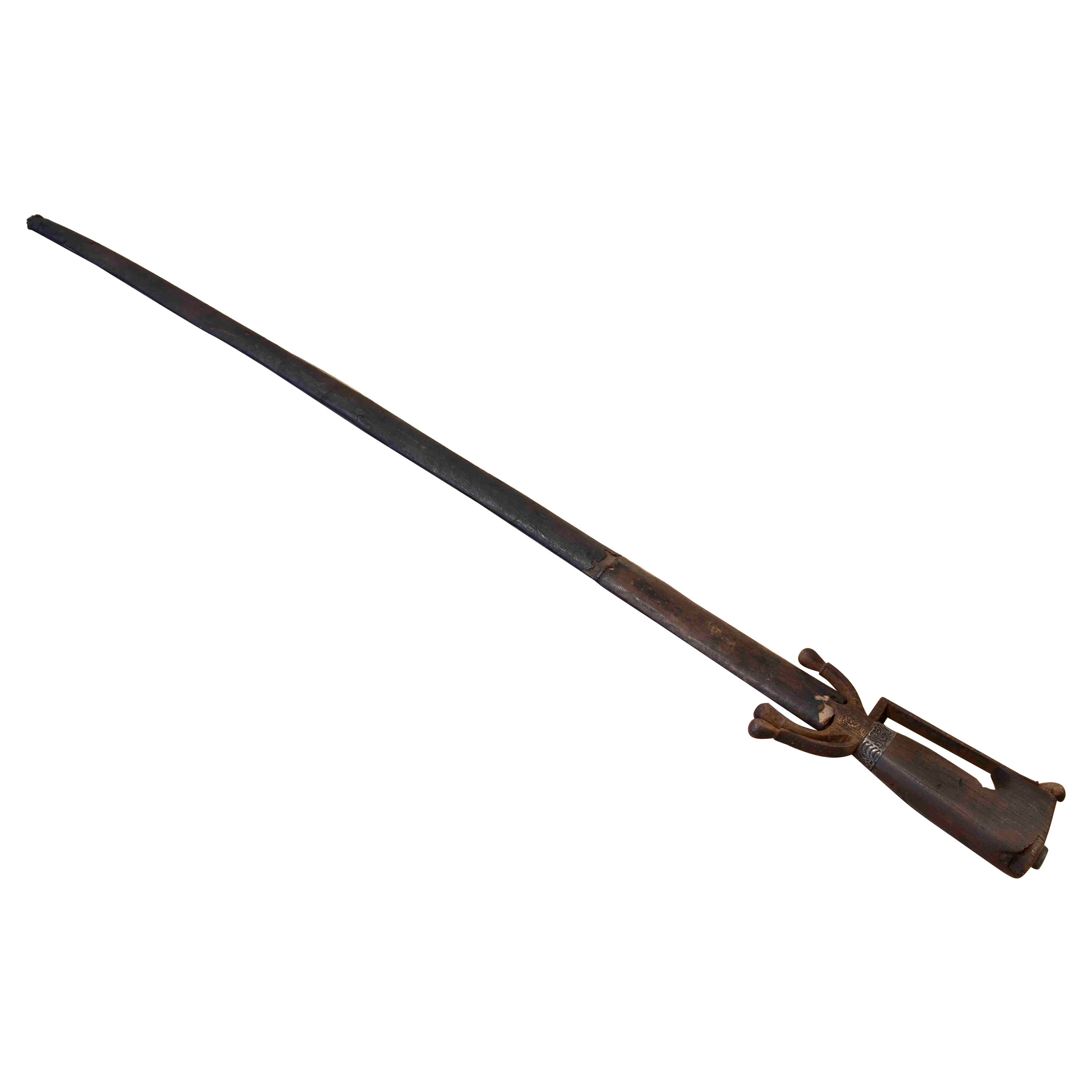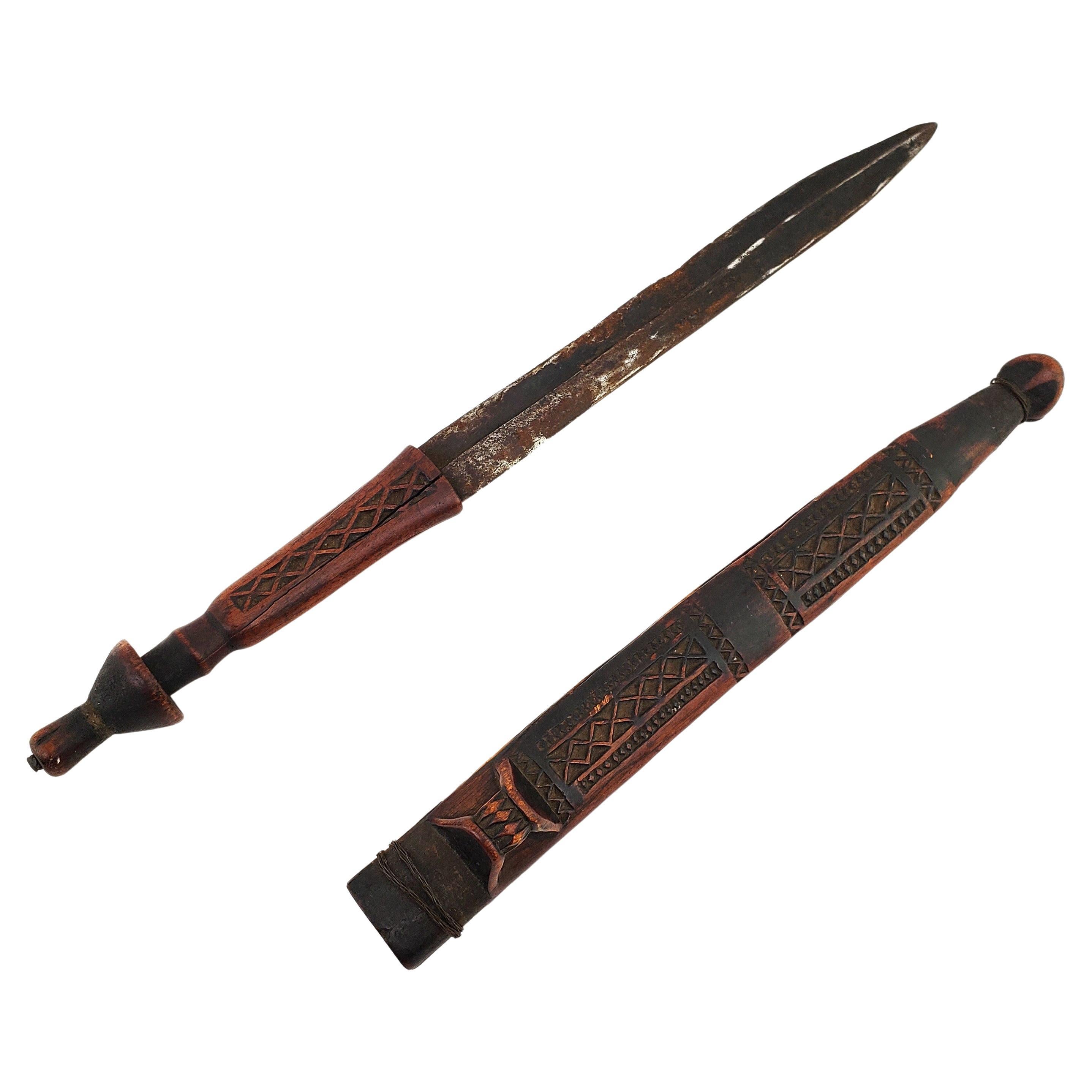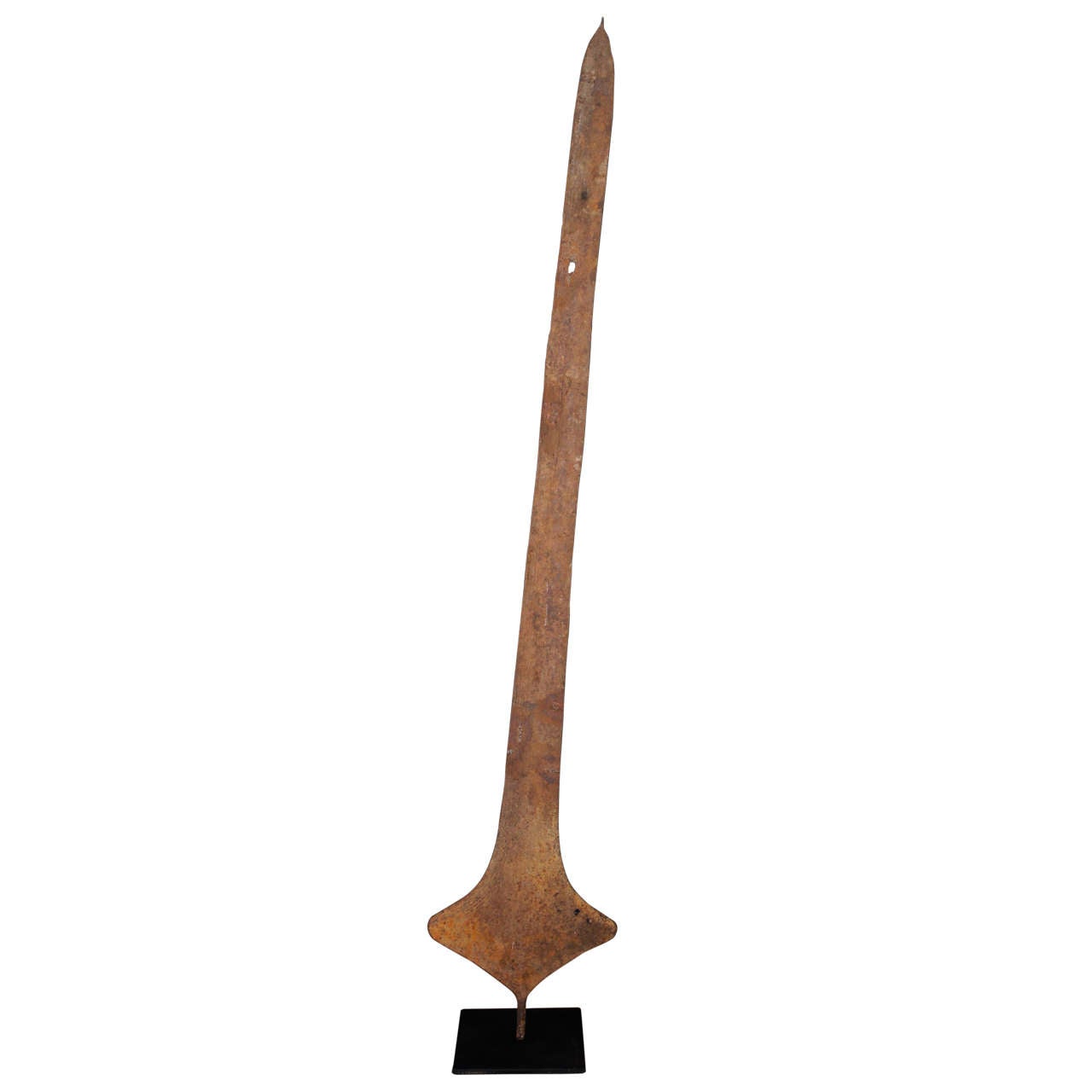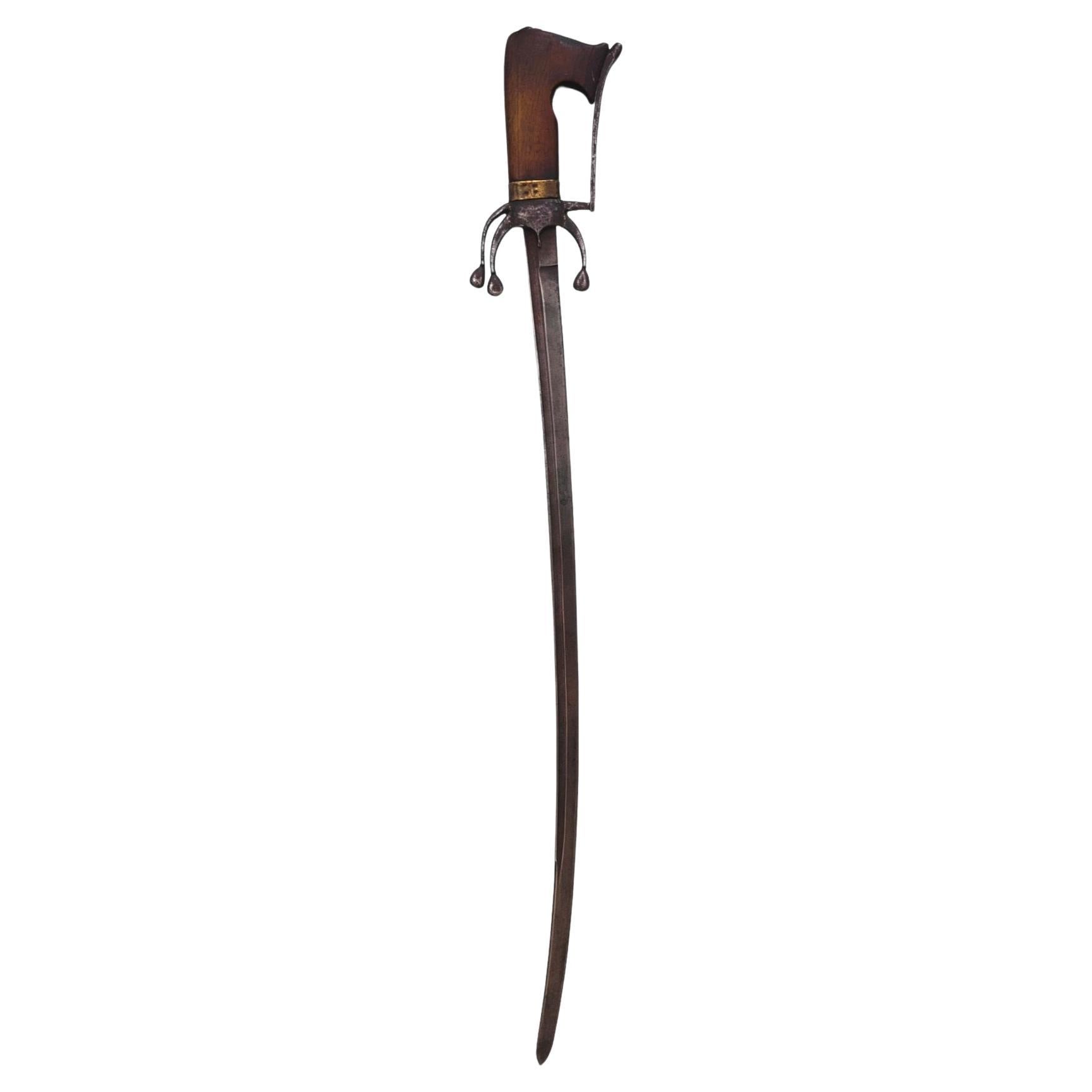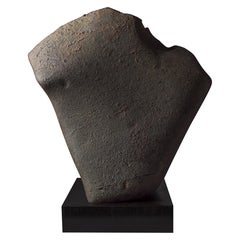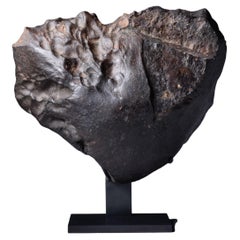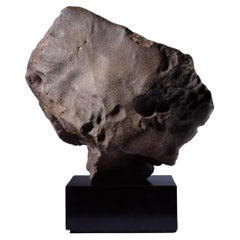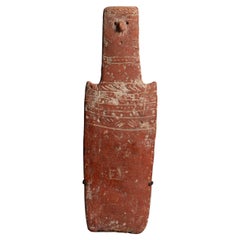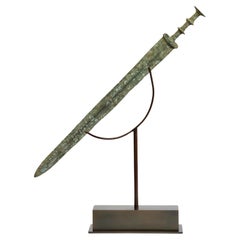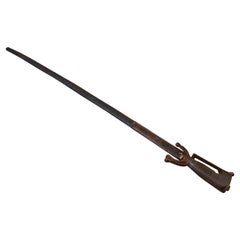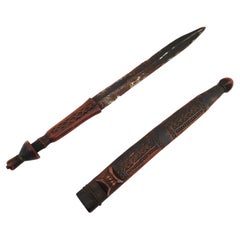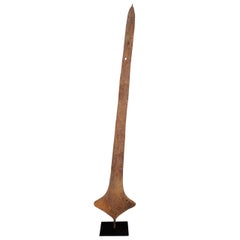Items Similar to Late Bronze Age Sword
Want more images or videos?
Request additional images or videos from the seller
1 of 8
Late Bronze Age Sword
$75,000
£56,600.44
€64,798.94
CA$105,774.87
A$116,127.61
CHF 60,584.02
MX$1,405,305.77
NOK 759,326.68
SEK 715,485.38
DKK 483,706.82
About the Item
Saint Nazaire Sword, Late Bronze Age, circa 800-900 B.C.
An exceptionally well preserved Bronze Age sword, with elegant, finely incised decorations, near perfect form and a wonderful, golden patina. Subtly leaf shaped and tapering to a fine point, this handsome bronze weapon is characteristic of an Atlantic sword of the Saint-Nazaire type. It has a tripartite flanged hilt, with straight horns and seven piercings for rivets to fasten a handle, five of which are still present. Five finely incised lines run from the notched ricasso along and around the raised midrib. The Saint-Nazaire type represents a transitional phase between the leaf-shaped and the so-called carp’s tongue swords of the Atlantic coastal areas of France in the Late Bronze Age.
This sword was most likely recovered from the bed of the River Saône, near Lyon, France, as suggested by the inscription “Saône-Près-Lyon” on the side of the hilt. The recovery of swords in rivers is a strong reminder of their past spiritual significance; the cult of the waters was particularly prominent during the Bronze Age, and it is highly probable that the present sword was deposited as a ritual offering to the river in which it was recovered, millennia later. The River Saône in particular is a very rich ground for the discovery of Bronze Age artefacts, and notably of Late Bronze Age swords. The retrieval of several Atlantic swords in the Saône, such as the present example, illustrates the numerous contacts and exchanges which must have taken place between the Atlantic and Continental cultural complexes at the time.
The development of bronze smithing in Europe coincided with the emergence of a new warrior elite, known to us from their elaborate burials, presiding over a network of competing chiefdoms. These masterfully crafted swords served to demonstrate their rank, and illustrate to us that this was a profoundly warlike culture, in which combat ability was highly prized. Indeed, recent studies, investigating the use-wear on weapons such as this, and what this can tell us about how those who wielded them fought, seem to suggest that Bronze Age swordsmanship was a carefully studied discipline, and that warriors of the period were a dedicated and highly trained class within their contemporary society.
“The weapons of the bronze age, the beauty of which arrests the attention of the most careless observer . stamps the ancient bronze workers not only as skilled mechanics, but as art work- men.”
Robert Day, Ulster journal of Archeology (1895)
Length: 71 cm (28 inches).
Provenance:
Recovered from the River Saône, near Lyon [according to a handwritten inscription on the hilt].
Collection of Monsieur F. B. (1950-2009), Normandy, France.
Subsequently French art market 2021 and exported under French Cultural Property Passport 233626.
- Dimensions:Height: 27.96 in (71 cm)Diameter: 2.37 in (6 cm)
- Materials and Techniques:
- Place of Origin:
- Period:
- Date of Manufacture:800 - 900 BC
- Condition:
- Seller Location:London, GB
- Reference Number:Seller: 429541stDibs: LU1052234448392
About the Seller
5.0
Recognized Seller
These prestigious sellers are industry leaders and represent the highest echelon for item quality and design.
Established in 2007
1stDibs seller since 2014
103 sales on 1stDibs
Typical response time: 6 hours
Associations
LAPADA - The Association of Arts & Antiques DealersInternational Confederation of Art and Antique Dealers' AssociationsThe British Antique Dealers' Association
- ShippingRetrieving quote...Shipping from: London, United Kingdom
- Return Policy
Authenticity Guarantee
In the unlikely event there’s an issue with an item’s authenticity, contact us within 1 year for a full refund. DetailsMoney-Back Guarantee
If your item is not as described, is damaged in transit, or does not arrive, contact us within 7 days for a full refund. Details24-Hour Cancellation
You have a 24-hour grace period in which to reconsider your purchase, with no questions asked.Vetted Professional Sellers
Our world-class sellers must adhere to strict standards for service and quality, maintaining the integrity of our listings.Price-Match Guarantee
If you find that a seller listed the same item for a lower price elsewhere, we’ll match it.Trusted Global Delivery
Our best-in-class carrier network provides specialized shipping options worldwide, including custom delivery.More From This Seller
View AllMonolithic Stone Meteorite
Located in London, GB
Unclassified Meteorite
Stone
Height: 36.83 cm
42.5 kg
A dramatic extraterrestrial sculpture, of monolithic form, covered in a thick grey-brown fusion crust and with areas of sandy deposits from untold years spent on the desert floor. Formed in the asteroid belt between Mars and Jupiter during the formation of our solar system, some 4.55 billion years ago, this large stone would have been separated from its parent body by an enormous impact before journeying through interplanetary space and eventually reaching Earth.
Upon atmospheric entry it would have reached cosmic velocity, heating the surrounding air to 1700°C and producing a large ball of fire. The heat was sufficient to melt the outer surface of the stone, exposing a new surface which in turn also melted away, losing as much as 95% of its initial mass before reaching the ground. The last molten layer to form as it collided with the Earth covered the stone in a layer of fusion crust, evidence of the incredible impact force delivered by this extraordinary specimen.
“This unclassified stone meteorite was found in Northwest Africa. It has a relatively smooth, dark brown, slightly weathered fusion crust; some small melt veins are visible on the surface. Due to the near-absence of terrestrial rocks in this region of the Sahara, meteorite hunting in this area has yielded many notable discoveries.”
Dr Alan E. Rubin, PhD Department of Earth, Planetary, and Space Sciences...
Category
Antique 15th Century and Earlier North African Natural Specimens
Materials
Stone
Oriented Stone Meteorite
Located in London, GB
Oriented Stone Meteorite
Chondrite
5.00 kg
Detached from its parent body by a mighty impact, this large, oriented Meteorite travelled over a hu...
Category
Antique 15th Century and Earlier North African Natural Specimens
Materials
Stone
Sculptural Oriented Meteorite
Located in London, GB
Oriented Chondrite Meteorite Circa 4.56 Billion y/o
Chondrite
24 x 20 cm, 28 cm tall on base
7.1 kg
A sculptural and beautifully weathered chondrite meteorite; upon entering the atmosphere, this extraterrestrial stone would have heated the surrounding air to a temperature of over 1700 C, higher than that of the hottest lava on the planet, and enough to melt away its outer layers, leaving its surface rippled with regmaglypts, thumb-shaped impressions formed as superheated rock streaked off of the main body as it careened toward the earth. The last layer of the rock to melt would have re-solidified as the meteorite made impact, forming a charcoal coloured fusion crust, which has taken on a deep ochre-tinted patina.
Chondrite meteorites such as this example were formed at the very beginning of our solar system, by the accretion of various types of dust and small grains, adrift in the vacuum of space and, as such, provide important clues about the birth of our own planet. This piece is an especially rare specimen, known as an oriented meteorite...
Category
Antique 15th Century and Earlier Natural Specimens
Materials
Stone
Cypriot Bronze Age Terracotta Plank Idol
Located in London, GB
This extremely well-preserved, stylised Cypriot plank idol is an iconic form of human representation from Bronze Age Cyprus. Made from burnished earthenware with lime-filled incision...
Category
Antique 15th Century and Earlier Cypriot Prehistoric Abstract Sculptures
Materials
Terracotta
Large Sculptural Iron Meteorite
Located in London, GB
Stony-iron, pallasite - PMG
Circa 4.5 Billion y/o
Weight: 34.68 kg
Height (including base): 53 cm
Width: 29 cm
A magnificent and extremely sculptural specimen of the Seymchan meteor...
Category
Antique 15th Century and Earlier Natural Specimens
Materials
Iron
Lunar Meteorite - A piece of the Moon
Located in London, GB
A beautiful fragment from a lunar meteorite, among the rarest of all geological finds. This specimen belongs to NWA 11303, a feldspathic regolith breccia which formed when the shock ...
Category
Antique 15th Century and Earlier Algerian Natural Specimens
Materials
Stone
You May Also Like
Ancient Antique Chinese Eastern Zhou Bronze Sword / Knife / Dagger with Stand
Located in Sampantawong, TH
Ancient Chinese bronze sword with nice green patina.
Age: China, Eastern Zhou Dynasty, 771 - 221 B.C.
Size of sword only: Length 56.3 C.M. / Width 4.8 C.M. / Thickness 3.7 C.M.
Heig...
Category
Antique 15th Century and Earlier Chinese Antiquities
Materials
Bronze
$3,000 Sale Price
20% Off
Sword with Wrought Iron Blade with Traces of Gold on Hilt with Cover Sheath
Located in Marbella, ES
Sword with Wrought Iron Blade with Traces of Gold on Hilt with Leather Cover Sheath
Category
Antique 17th Century Arms, Armor and Weapons
Materials
Gold, Wrought Iron
19th Century African Shona Dagger
Located in Hamilton, Ontario
19th Century dagger from the Shona people of Zimbabwe. It features beautiful carvings, a rich aged patina and a handmade steeped blade.
Category
Antique 1890s Zimbabwean Arms, Armor and Weapons
Materials
Metal
An Unusually Large 19th Century Topoke Tribe Currency Sword
Located in Hudson, NY
This currency sword, like most African trade currency items, was used as a way to transfer wealth for the purpose of buying land or animals but is most ...
Category
Antique 19th Century Congolese Tribal Collectibles and Curiosities
Materials
Iron
English Renaissance Style Steel and Leather Spear
Located in Queens, NY
English Renaissance-style spear with crossed leather covered shaft and polished steel blade.
Category
20th Century English Northern Renaissance Arms, Armor and Weapons
Materials
Iron
North African Sword (Nimcha), Morocco, Early 19th Century
Located in Madrid, ES
North African Sword (Nimcha), Morocco, Early 19th Century
This North African sword, known as a "Nimcha," is a remarkable piece originating from Morocco, dating back to the early 19th...
Category
Antique Late 19th Century Arms, Armor and Weapons
Materials
Wrought Iron
